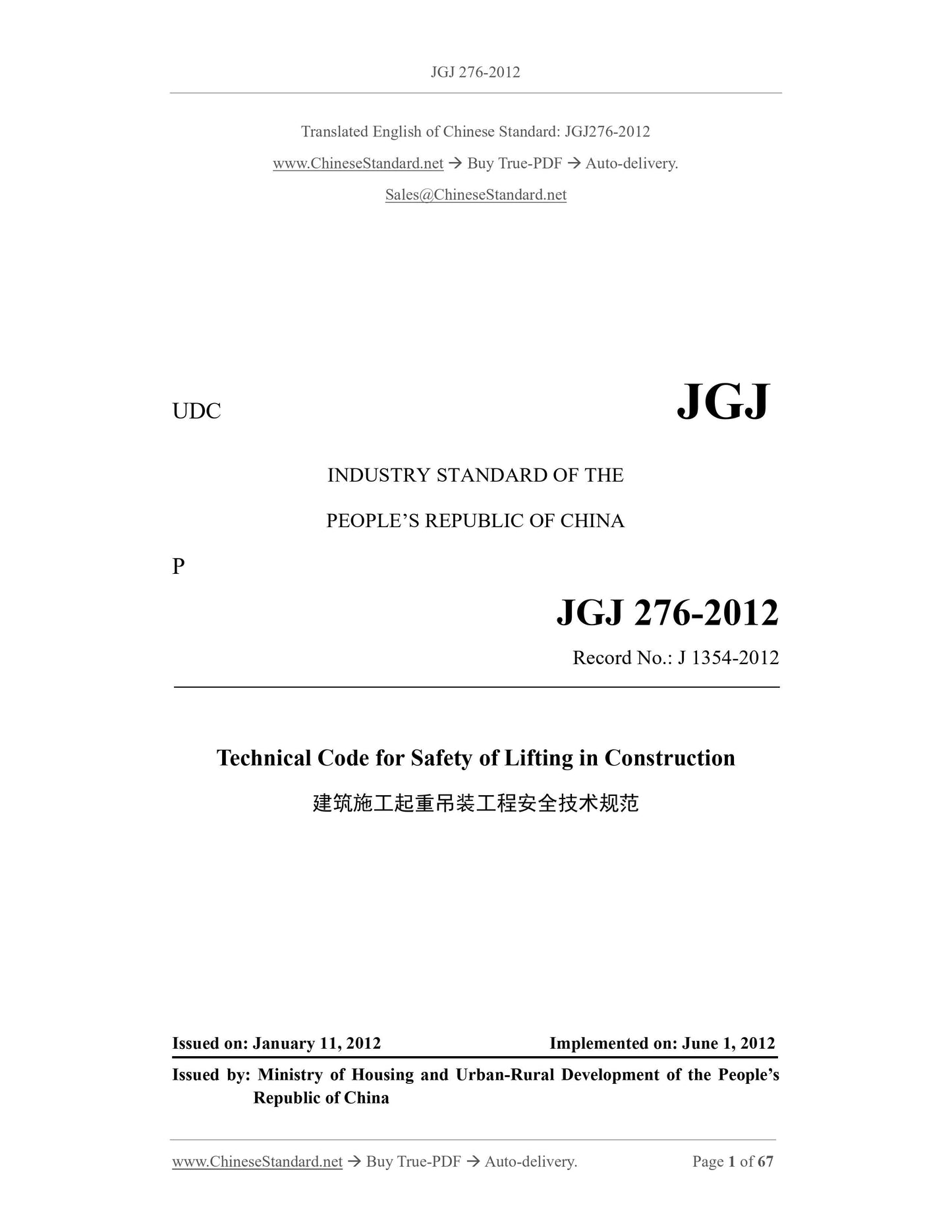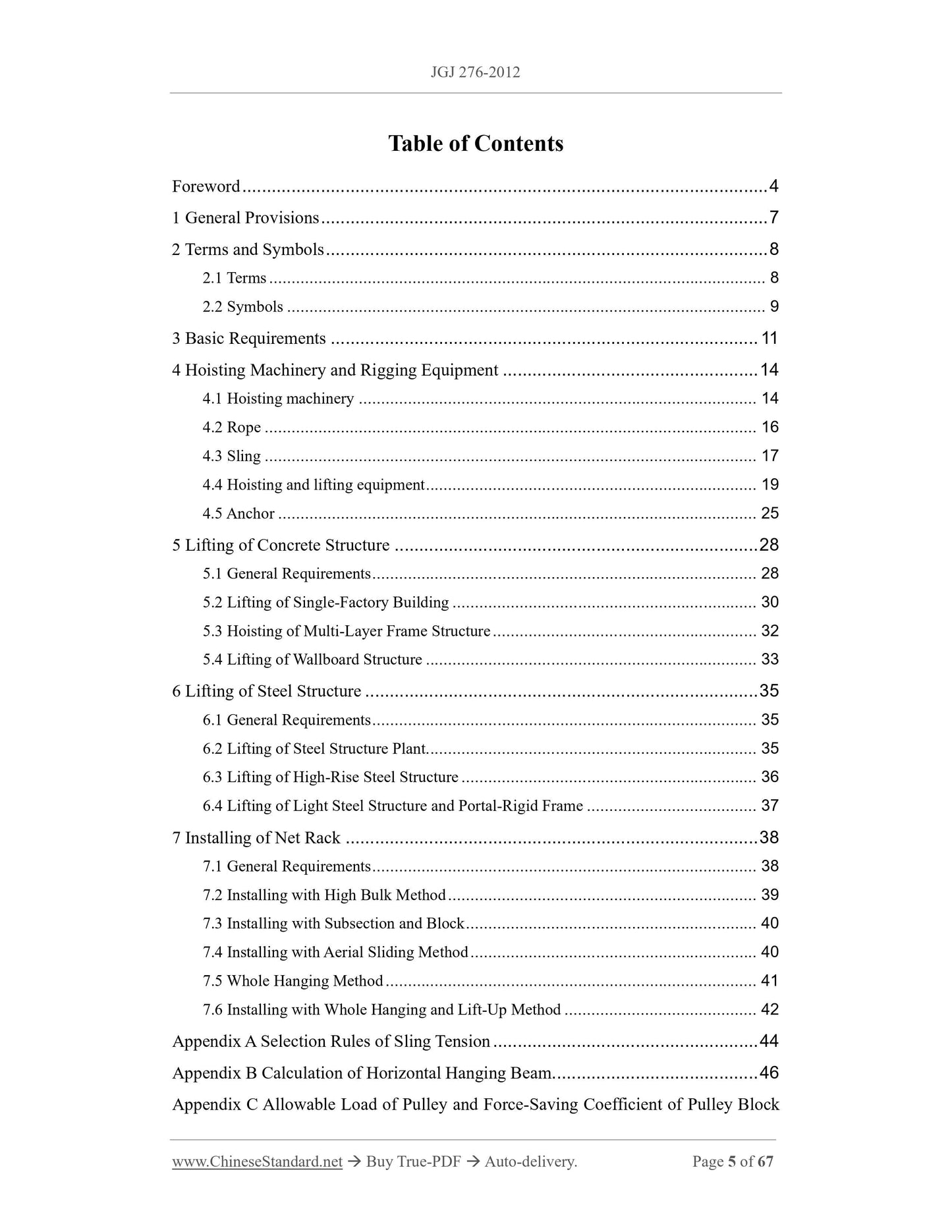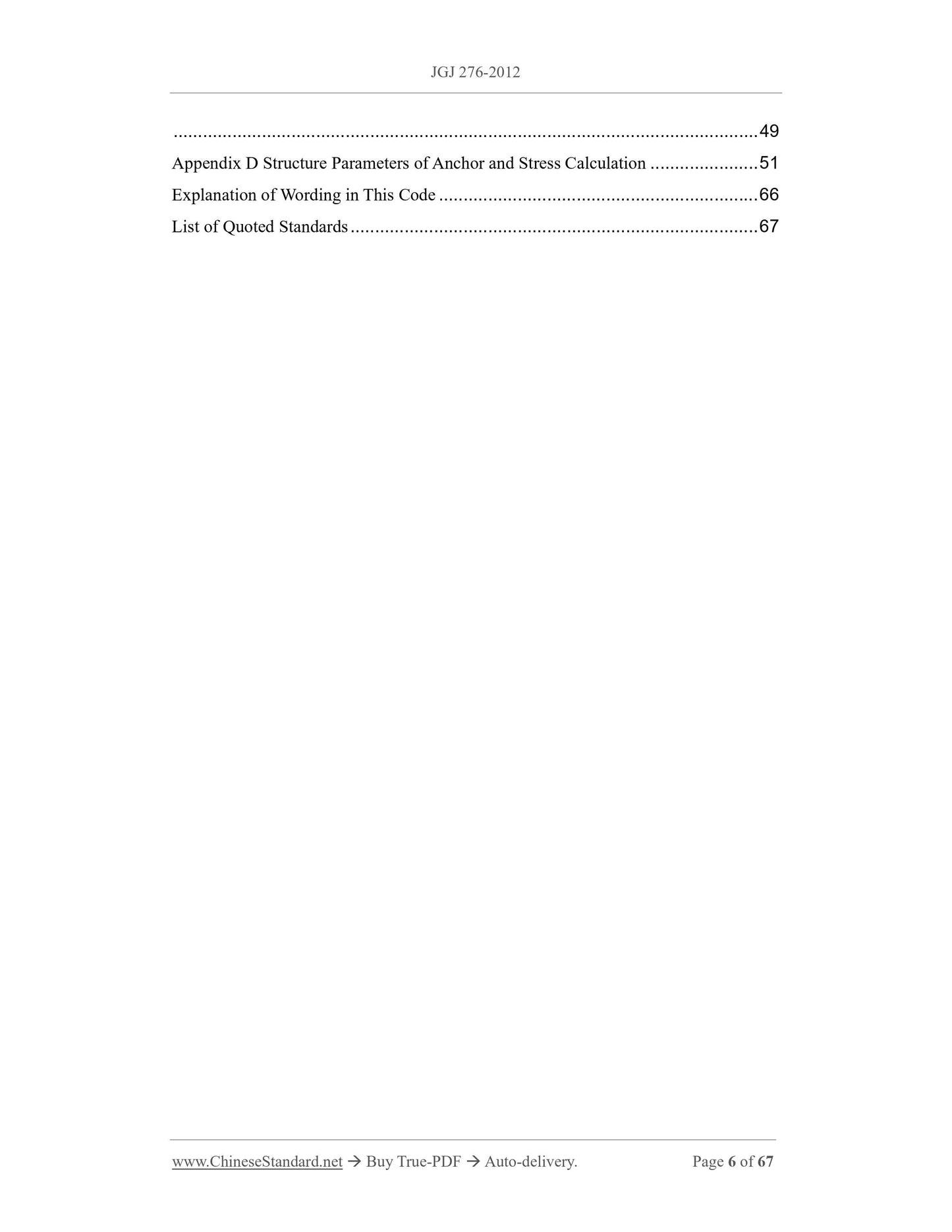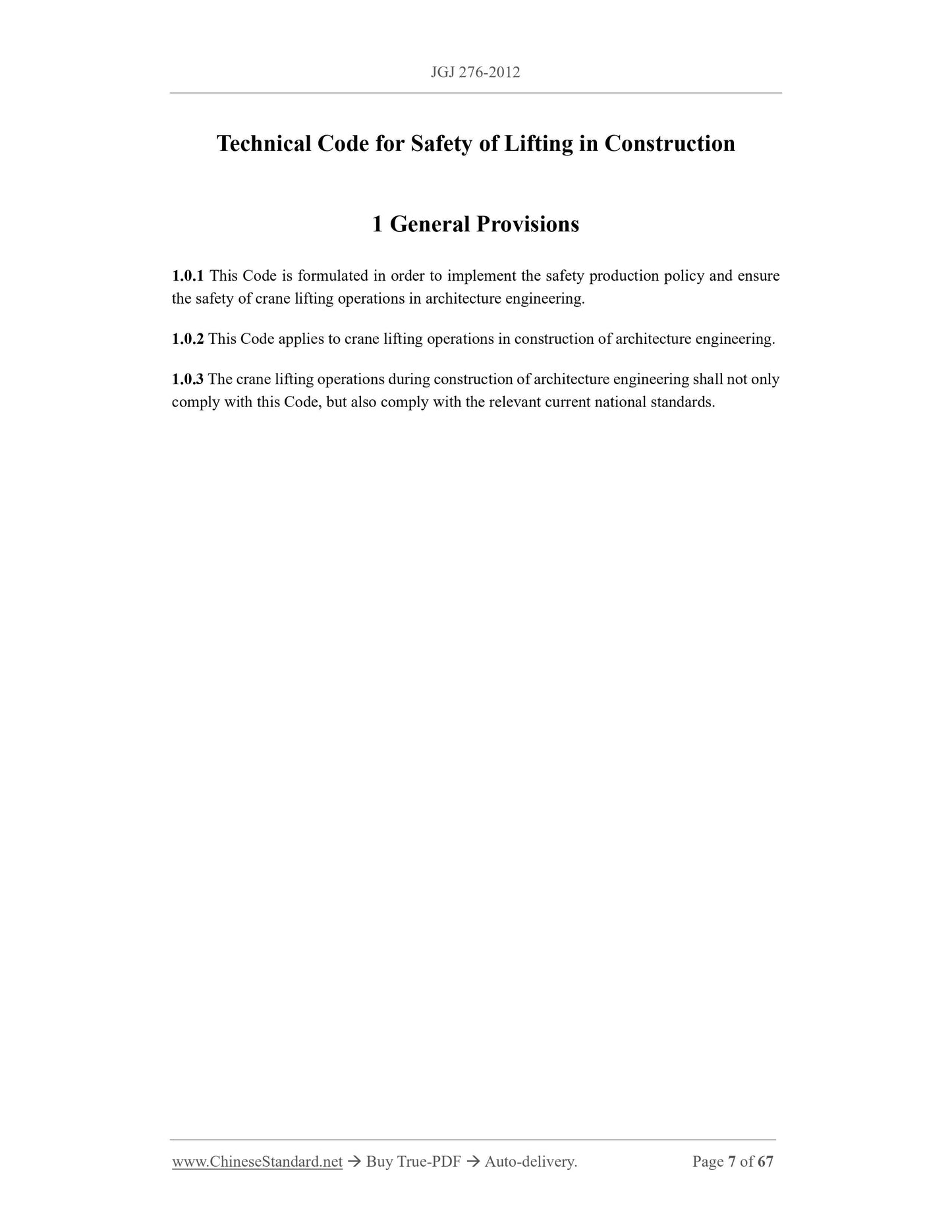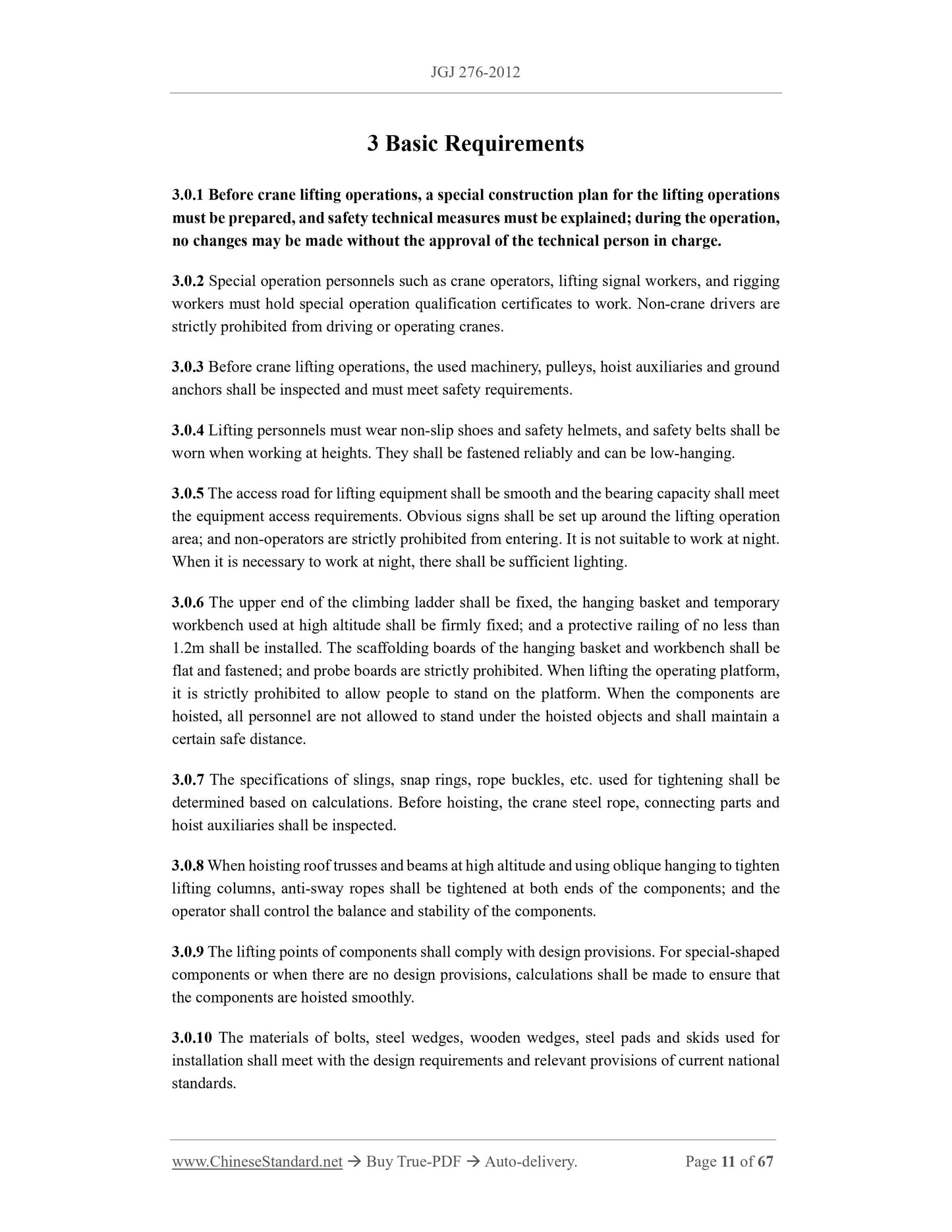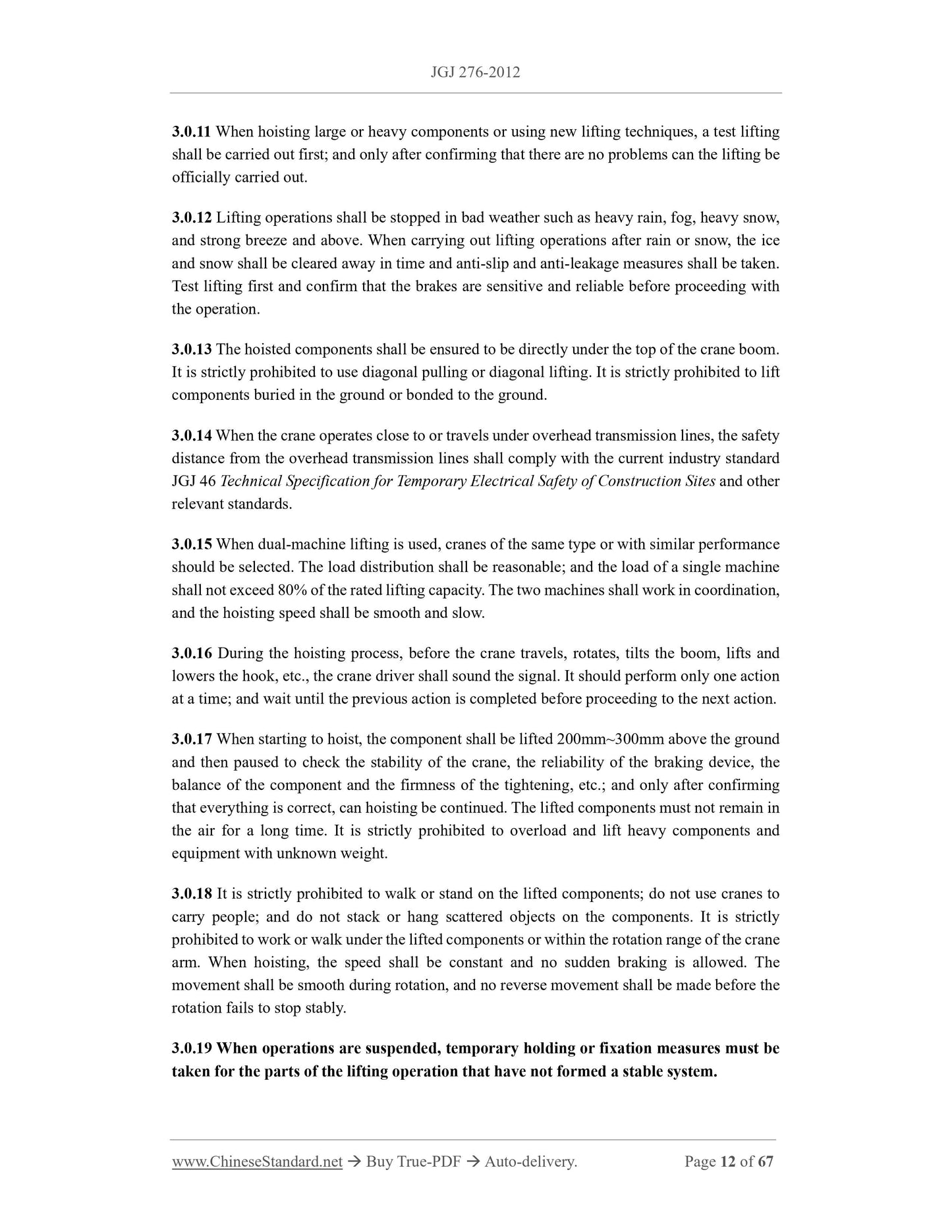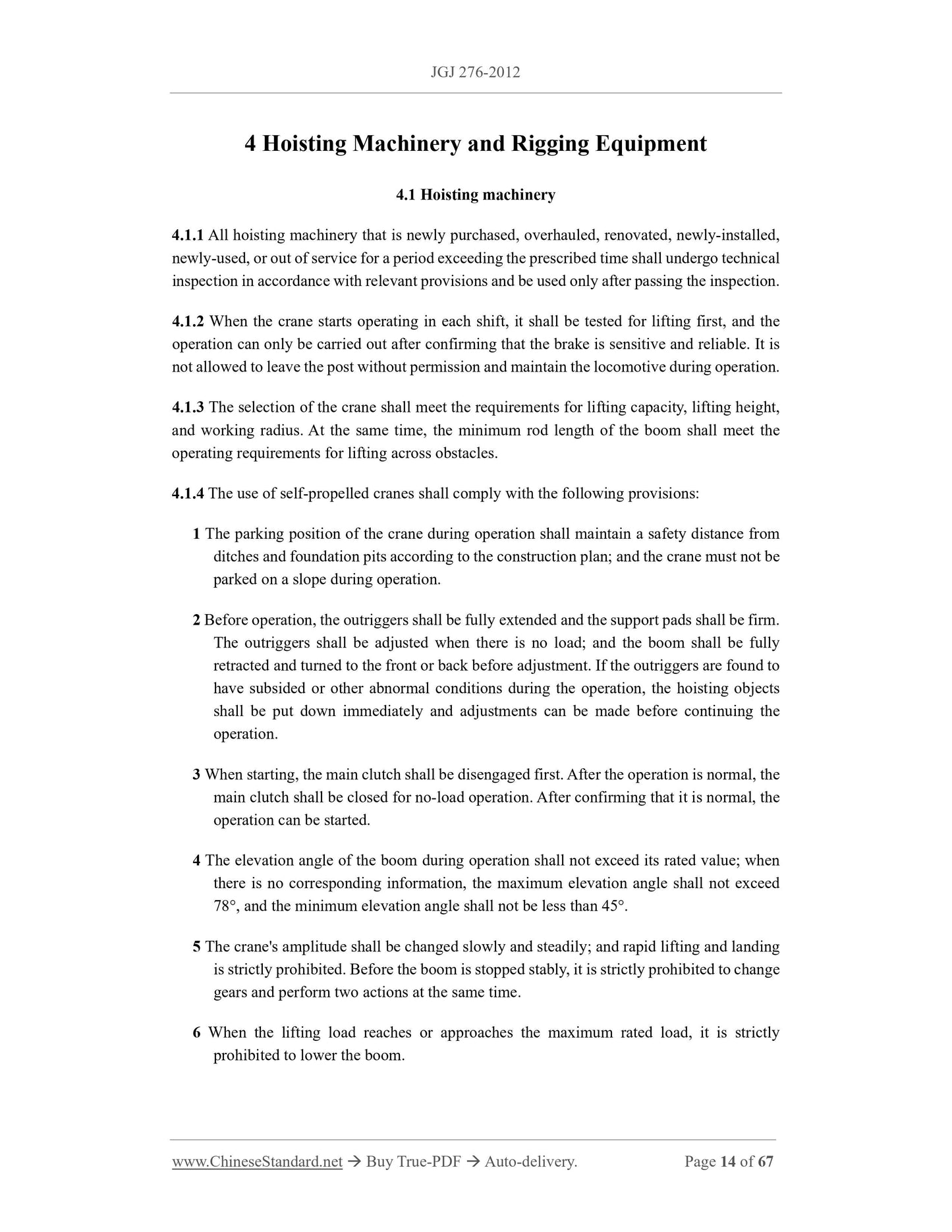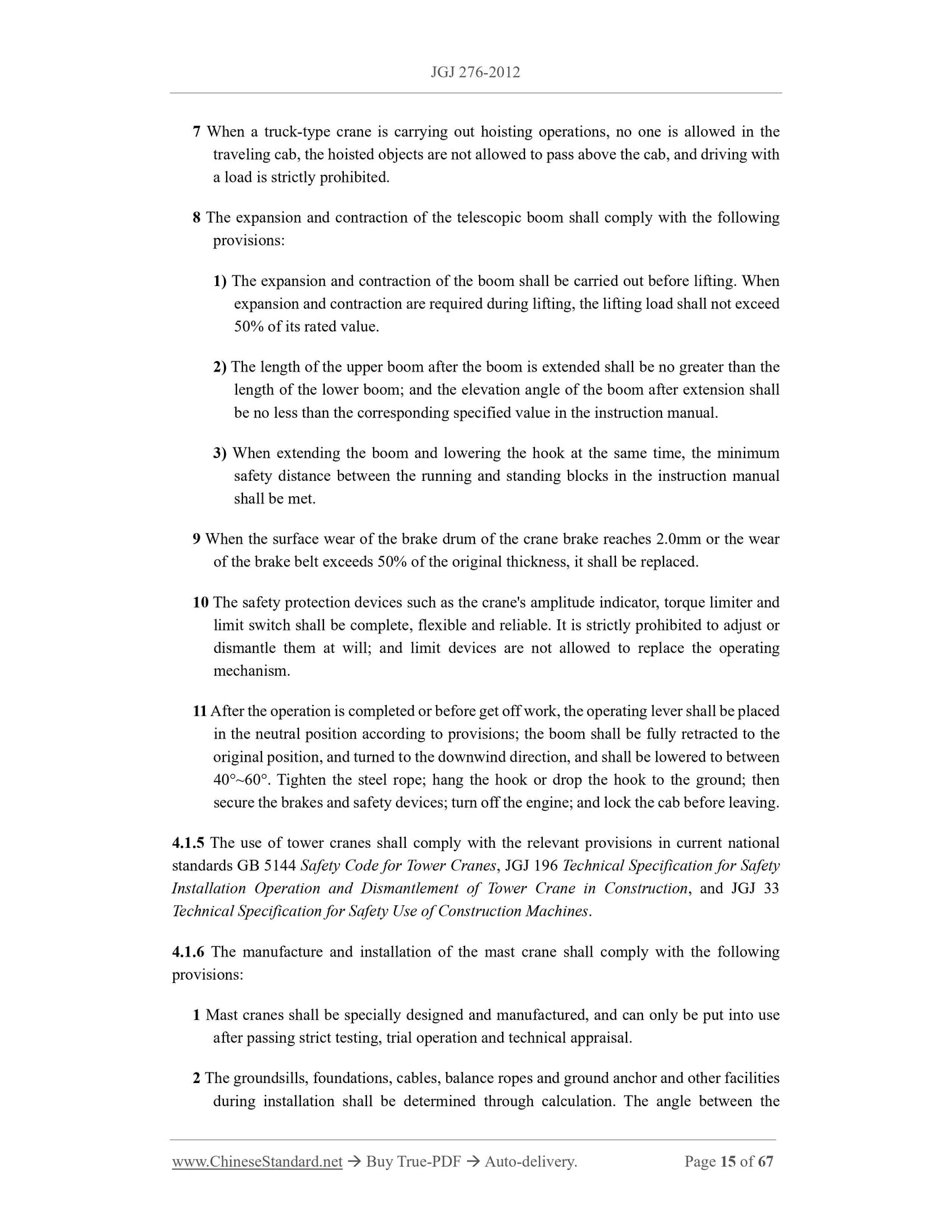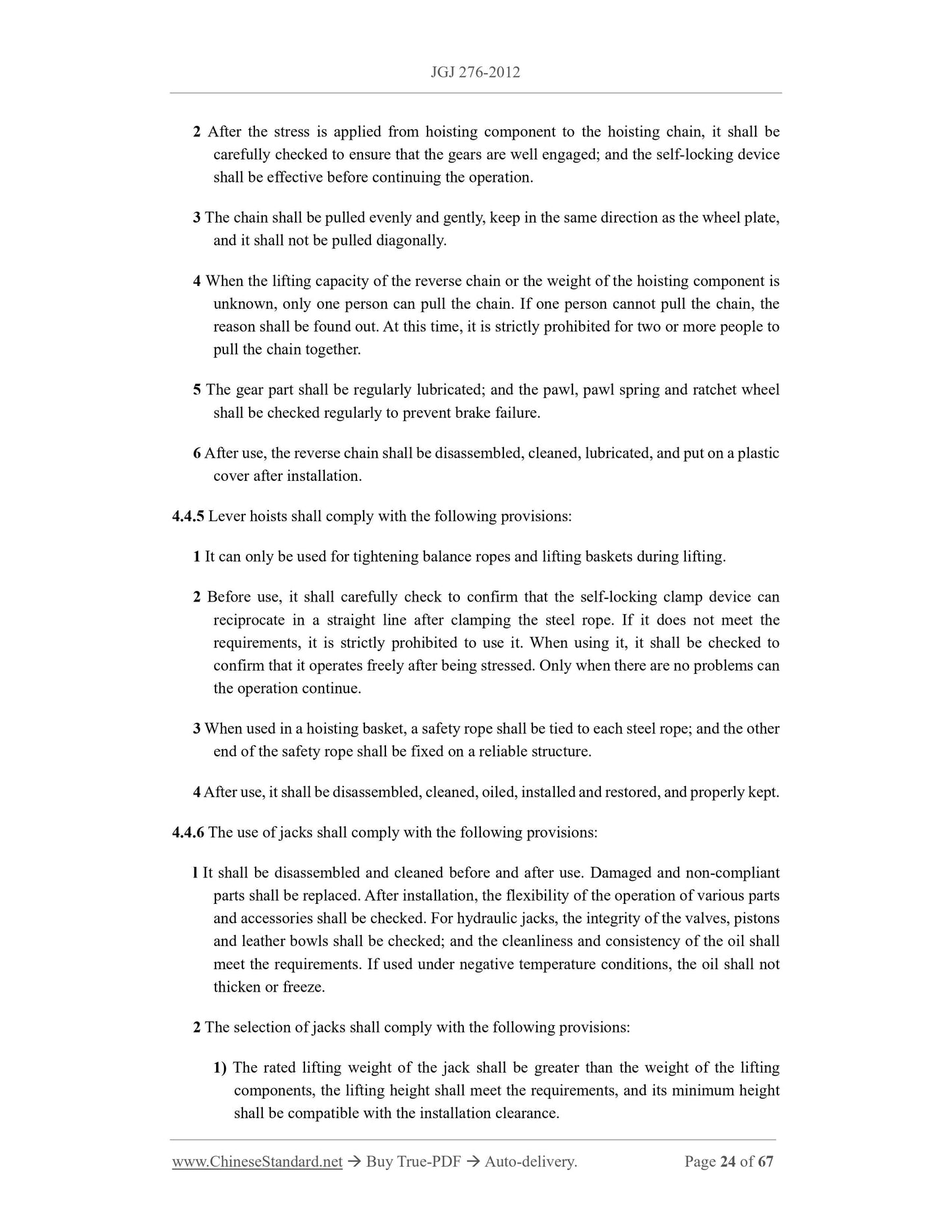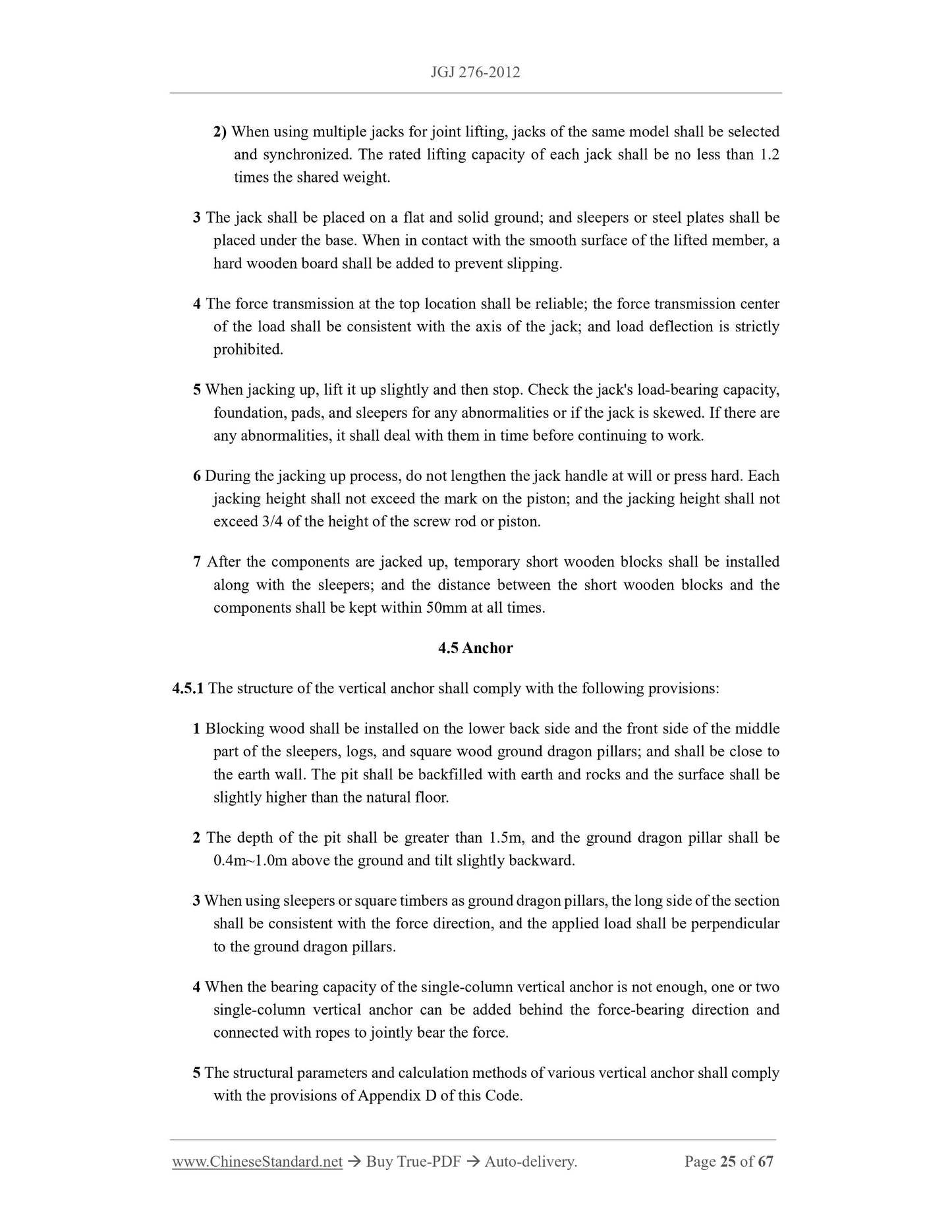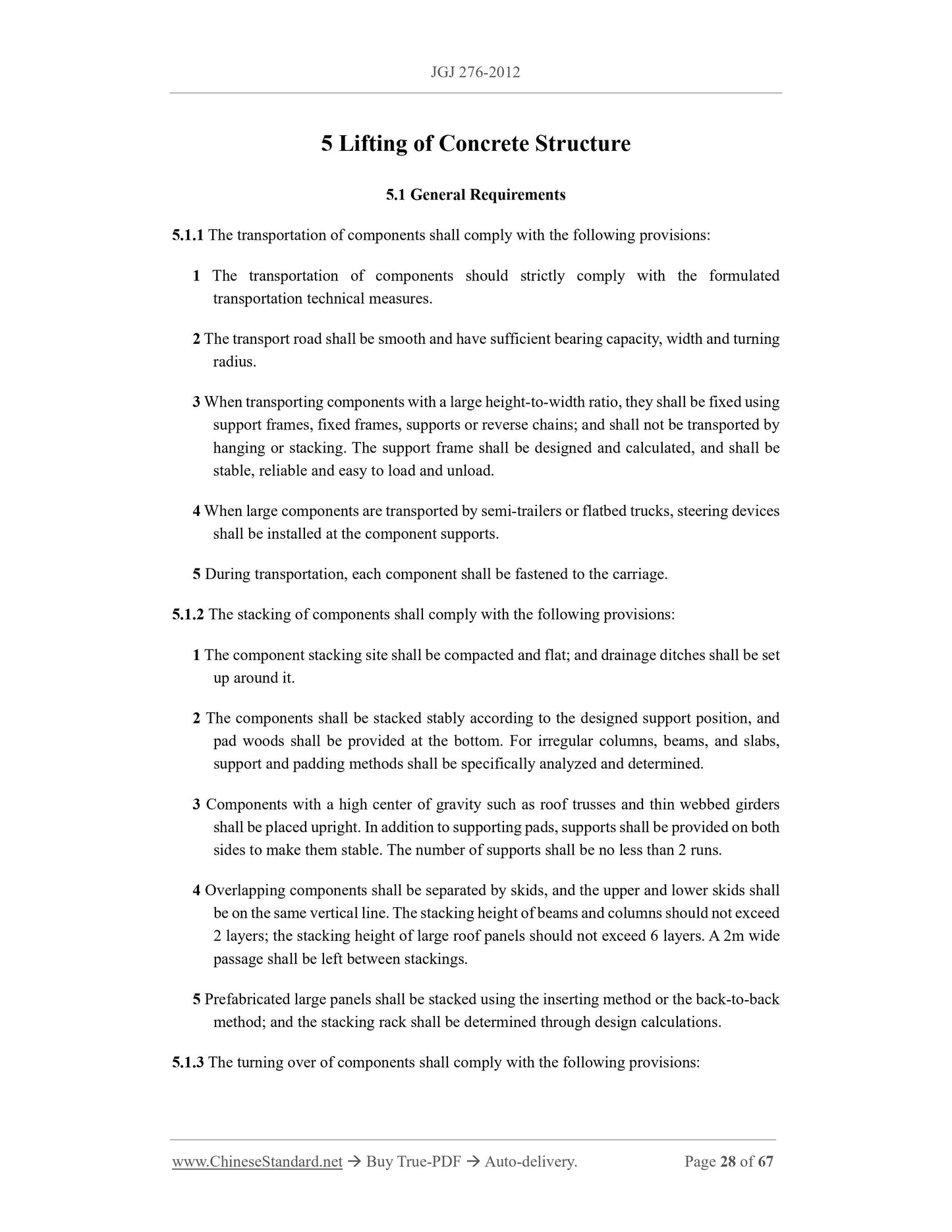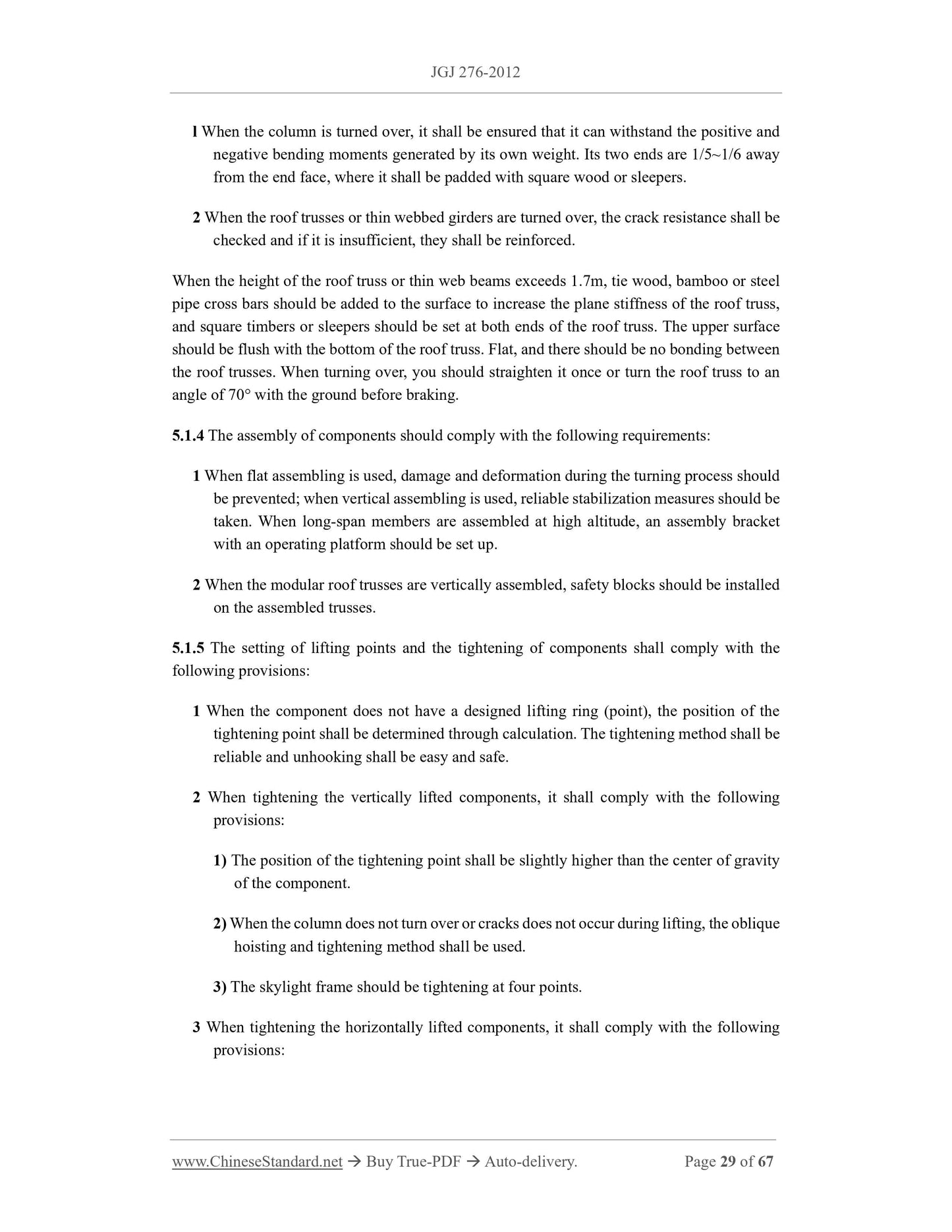1
/
of
12
PayPal, credit cards. Download editable-PDF and invoice in 1 second!
JGJ 276-2012 English PDF (JGJ276-2012)
JGJ 276-2012 English PDF (JGJ276-2012)
Regular price
$1,520.00 USD
Regular price
Sale price
$1,520.00 USD
Unit price
/
per
Shipping calculated at checkout.
Couldn't load pickup availability
Delivery: 3 seconds. Download true-PDF + Invoice.
Get QUOTATION in 1-minute: Click JGJ 276-2012
Historical versions: JGJ 276-2012
Preview True-PDF (Reload/Scroll if blank)
JGJ 276-2012: Technical code for safety of lifting in construction
JGJ 276-2012
UDC JGJ
INDUSTRY STANDARD OF THE
PEOPLE’S REPUBLIC OF CHINA
Record No.: J 1354-2012
Technical Code for Safety of Lifting in Construction
ISSUED ON: JANUARY 11, 2012
IMPLEMENTED ON: JUNE 1, 2012
Issued by: Ministry of Housing and Urban-Rural Development of the People’s
Republic of China
Table of Contents
Foreword ... 4
1 General Provisions ... 7
2 Terms and Symbols ... 8
2.1 Terms ... 8
2.2 Symbols ... 9
3 Basic Requirements ... 11
4 Hoisting Machinery and Rigging Equipment ... 14
4.1 Hoisting machinery ... 14
4.2 Rope ... 16
4.3 Sling ... 17
4.4 Hoisting and lifting equipment ... 19
4.5 Anchor ... 25
5 Lifting of Concrete Structure ... 28
5.1 General Requirements ... 28
5.2 Lifting of Single-Factory Building ... 30
5.3 Hoisting of Multi-Layer Frame Structure ... 32
5.4 Lifting of Wallboard Structure ... 33
6 Lifting of Steel Structure ... 35
6.1 General Requirements ... 35
6.2 Lifting of Steel Structure Plant... 35
6.3 Lifting of High-Rise Steel Structure ... 36
6.4 Lifting of Light Steel Structure and Portal-Rigid Frame ... 37
7 Installing of Net Rack ... 38
7.1 General Requirements ... 38
7.2 Installing with High Bulk Method ... 39
7.3 Installing with Subsection and Block ... 40
7.4 Installing with Aerial Sliding Method ... 40
7.5 Whole Hanging Method ... 41
7.6 Installing with Whole Hanging and Lift-Up Method ... 42
Appendix A Selection Rules of Sling Tension ... 44
Appendix B Calculation of Horizontal Hanging Beam ... 46
Appendix C Allowable Load of Pulley and Force-Saving Coefficient of Pulley Block
... 49
Appendix D Structure Parameters of Anchor and Stress Calculation ... 51
Explanation of Wording in This Code ... 66
List of Quoted Standards ... 67
Technical Code for Safety of Lifting in Construction
1 General Provisions
1.0.1 This Code is formulated in order to implement the safety production policy and ensure
the safety of crane lifting operations in architecture engineering.
1.0.2 This Code applies to crane lifting operations in construction of architecture engineering.
1.0.3 The crane lifting operations during construction of architecture engineering shall not only
comply with this Code, but also comply with the relevant current national standards.
3 Basic Requirements
3.0.1 Before crane lifting operations, a special construction plan for the lifting operations
must be prepared, and safety technical measures must be explained; during the operation,
no changes may be made without the approval of the technical person in charge.
3.0.2 Special operation personnels such as crane operators, lifting signal workers, and rigging
workers must hold special operation qualification certificates to work. Non-crane drivers are
strictly prohibited from driving or operating cranes.
3.0.3 Before crane lifting operations, the used machinery, pulleys, hoist auxiliaries and ground
anchors shall be inspected and must meet safety requirements.
3.0.4 Lifting personnels must wear non-slip shoes and safety helmets, and safety belts shall be
worn when working at heights. They shall be fastened reliably and can be low-hanging.
3.0.5 The access road for lifting equipment shall be smooth and the bearing capacity shall meet
the equipment access requirements. Obvious signs shall be set up around the lifting operation
area; and non-operators are strictly prohibited from entering. It is not suitable to work at night.
When it is necessary to work at night, there shall be sufficient lighting.
3.0.6 The upper end of the climbing ladder shall be fixed, the hanging basket and temporary
workbench used at high altitude shall be firmly fixed; and a protective railing of no less than
1.2m shall be installed. The scaffolding boards of the hanging basket and workbench shall be
flat and fastened; and probe boards are strictly prohibited. When lifting the operating platform,
it is strictly prohibited to allow people to stand on the platform. When the components are
hoisted, all personnel are not allowed to stand under the hoisted objects and shall maintain a
certain safe distance.
3.0.7 The specifications of slings, snap rings, rope buckles, etc. used for tightening shall be
determined based on calculations. Before hoisting, the crane steel rope, connecting parts and
hoist auxiliaries shall be inspected.
3.0.8 When hoisting roof trusses and beams at high altitude and using oblique hanging to tighten
lifting columns, anti-sway ropes shall be tightened at both ends of the components; and the
operator shall control the balance and stability of the components.
3.0.9 The lifting points of components shall comply with design provisions. For special-shaped
components or when there are no design provisions, calculations shall be made to ensure that
the components are hoisted smoothly.
3.0.10 The materials of bolts, steel wedges, wooden wedges, steel pads and skids used for
installation shall meet with the design requirements and relevant provisions of current national
standards.
3.0.11 When hoisting large or heavy components or using new lifting techniques, a test lifting
shall be carried out first; and only after confirming that there are no problems can the lifting be
officially carried out.
3.0.12 Lifting operations shall be stopped in bad weather such as heavy rain, fog, heavy snow,
and strong breeze and above. When carrying out lifting operations after rain or snow, the ice
and snow shall be cleared away in time and anti-slip and anti-leakage measures shall be taken.
Test lifting first and confirm that the brakes are sensitive and reliable before proceeding with
the operation.
3.0.13 The hoisted components shall be ensured to be directly under the top of the crane boom.
It is strictly prohibited to use diagonal pulling or diagonal lifting. It is strictly prohibited to lift
components buried in the ground or bonded to the ground.
3.0.14 When the crane operates close to or travels under overhead transmission lines, the safety
distance from the overhead transmission lines shall comply with the current industry standard
JGJ 46 Technical Specification for Temporary Electrical Safety of Construction Sites and other
relevant standards.
3.0.15 When dual-machine lifting is used, cranes of the same type or with similar performance
should be selected. The load distribution shall be reasonable; and the load of a single machine
shall not exceed 80% of the rated lifting capacity. The two machines shall work in coordination,
and the hoisting speed shall be smooth and slow.
3.0.16 During the hoisting process, before the crane travels, rotates, tilts the boom, lifts and
lowers the hook, etc., the crane driver shall sound the signal. It should perform only one action
at a time; and wait until the previous action is completed before proceeding to the next action.
3.0.17 When starting to hoist, the component shall be lifted 200mm~300mm above the ground
and then paused to check the stability of the crane, the reliability of the braking device, the
balance of the component and the firmness of the tightening, etc.; and only after confirming
that everything is correct, can hoisting be continued. The lifted components must not remain in
the air for a long time. It is strictly prohibited to overload and lift heavy components and
equipment with unknown weight.
3.0.18 It is strictly prohibited to walk or stand on the lifted components; do not use cranes to
carry people; and do not stack or hang scattered objects on the componen...
Get QUOTATION in 1-minute: Click JGJ 276-2012
Historical versions: JGJ 276-2012
Preview True-PDF (Reload/Scroll if blank)
JGJ 276-2012: Technical code for safety of lifting in construction
JGJ 276-2012
UDC JGJ
INDUSTRY STANDARD OF THE
PEOPLE’S REPUBLIC OF CHINA
Record No.: J 1354-2012
Technical Code for Safety of Lifting in Construction
ISSUED ON: JANUARY 11, 2012
IMPLEMENTED ON: JUNE 1, 2012
Issued by: Ministry of Housing and Urban-Rural Development of the People’s
Republic of China
Table of Contents
Foreword ... 4
1 General Provisions ... 7
2 Terms and Symbols ... 8
2.1 Terms ... 8
2.2 Symbols ... 9
3 Basic Requirements ... 11
4 Hoisting Machinery and Rigging Equipment ... 14
4.1 Hoisting machinery ... 14
4.2 Rope ... 16
4.3 Sling ... 17
4.4 Hoisting and lifting equipment ... 19
4.5 Anchor ... 25
5 Lifting of Concrete Structure ... 28
5.1 General Requirements ... 28
5.2 Lifting of Single-Factory Building ... 30
5.3 Hoisting of Multi-Layer Frame Structure ... 32
5.4 Lifting of Wallboard Structure ... 33
6 Lifting of Steel Structure ... 35
6.1 General Requirements ... 35
6.2 Lifting of Steel Structure Plant... 35
6.3 Lifting of High-Rise Steel Structure ... 36
6.4 Lifting of Light Steel Structure and Portal-Rigid Frame ... 37
7 Installing of Net Rack ... 38
7.1 General Requirements ... 38
7.2 Installing with High Bulk Method ... 39
7.3 Installing with Subsection and Block ... 40
7.4 Installing with Aerial Sliding Method ... 40
7.5 Whole Hanging Method ... 41
7.6 Installing with Whole Hanging and Lift-Up Method ... 42
Appendix A Selection Rules of Sling Tension ... 44
Appendix B Calculation of Horizontal Hanging Beam ... 46
Appendix C Allowable Load of Pulley and Force-Saving Coefficient of Pulley Block
... 49
Appendix D Structure Parameters of Anchor and Stress Calculation ... 51
Explanation of Wording in This Code ... 66
List of Quoted Standards ... 67
Technical Code for Safety of Lifting in Construction
1 General Provisions
1.0.1 This Code is formulated in order to implement the safety production policy and ensure
the safety of crane lifting operations in architecture engineering.
1.0.2 This Code applies to crane lifting operations in construction of architecture engineering.
1.0.3 The crane lifting operations during construction of architecture engineering shall not only
comply with this Code, but also comply with the relevant current national standards.
3 Basic Requirements
3.0.1 Before crane lifting operations, a special construction plan for the lifting operations
must be prepared, and safety technical measures must be explained; during the operation,
no changes may be made without the approval of the technical person in charge.
3.0.2 Special operation personnels such as crane operators, lifting signal workers, and rigging
workers must hold special operation qualification certificates to work. Non-crane drivers are
strictly prohibited from driving or operating cranes.
3.0.3 Before crane lifting operations, the used machinery, pulleys, hoist auxiliaries and ground
anchors shall be inspected and must meet safety requirements.
3.0.4 Lifting personnels must wear non-slip shoes and safety helmets, and safety belts shall be
worn when working at heights. They shall be fastened reliably and can be low-hanging.
3.0.5 The access road for lifting equipment shall be smooth and the bearing capacity shall meet
the equipment access requirements. Obvious signs shall be set up around the lifting operation
area; and non-operators are strictly prohibited from entering. It is not suitable to work at night.
When it is necessary to work at night, there shall be sufficient lighting.
3.0.6 The upper end of the climbing ladder shall be fixed, the hanging basket and temporary
workbench used at high altitude shall be firmly fixed; and a protective railing of no less than
1.2m shall be installed. The scaffolding boards of the hanging basket and workbench shall be
flat and fastened; and probe boards are strictly prohibited. When lifting the operating platform,
it is strictly prohibited to allow people to stand on the platform. When the components are
hoisted, all personnel are not allowed to stand under the hoisted objects and shall maintain a
certain safe distance.
3.0.7 The specifications of slings, snap rings, rope buckles, etc. used for tightening shall be
determined based on calculations. Before hoisting, the crane steel rope, connecting parts and
hoist auxiliaries shall be inspected.
3.0.8 When hoisting roof trusses and beams at high altitude and using oblique hanging to tighten
lifting columns, anti-sway ropes shall be tightened at both ends of the components; and the
operator shall control the balance and stability of the components.
3.0.9 The lifting points of components shall comply with design provisions. For special-shaped
components or when there are no design provisions, calculations shall be made to ensure that
the components are hoisted smoothly.
3.0.10 The materials of bolts, steel wedges, wooden wedges, steel pads and skids used for
installation shall meet with the design requirements and relevant provisions of current national
standards.
3.0.11 When hoisting large or heavy components or using new lifting techniques, a test lifting
shall be carried out first; and only after confirming that there are no problems can the lifting be
officially carried out.
3.0.12 Lifting operations shall be stopped in bad weather such as heavy rain, fog, heavy snow,
and strong breeze and above. When carrying out lifting operations after rain or snow, the ice
and snow shall be cleared away in time and anti-slip and anti-leakage measures shall be taken.
Test lifting first and confirm that the brakes are sensitive and reliable before proceeding with
the operation.
3.0.13 The hoisted components shall be ensured to be directly under the top of the crane boom.
It is strictly prohibited to use diagonal pulling or diagonal lifting. It is strictly prohibited to lift
components buried in the ground or bonded to the ground.
3.0.14 When the crane operates close to or travels under overhead transmission lines, the safety
distance from the overhead transmission lines shall comply with the current industry standard
JGJ 46 Technical Specification for Temporary Electrical Safety of Construction Sites and other
relevant standards.
3.0.15 When dual-machine lifting is used, cranes of the same type or with similar performance
should be selected. The load distribution shall be reasonable; and the load of a single machine
shall not exceed 80% of the rated lifting capacity. The two machines shall work in coordination,
and the hoisting speed shall be smooth and slow.
3.0.16 During the hoisting process, before the crane travels, rotates, tilts the boom, lifts and
lowers the hook, etc., the crane driver shall sound the signal. It should perform only one action
at a time; and wait until the previous action is completed before proceeding to the next action.
3.0.17 When starting to hoist, the component shall be lifted 200mm~300mm above the ground
and then paused to check the stability of the crane, the reliability of the braking device, the
balance of the component and the firmness of the tightening, etc.; and only after confirming
that everything is correct, can hoisting be continued. The lifted components must not remain in
the air for a long time. It is strictly prohibited to overload and lift heavy components and
equipment with unknown weight.
3.0.18 It is strictly prohibited to walk or stand on the lifted components; do not use cranes to
carry people; and do not stack or hang scattered objects on the componen...
Share
